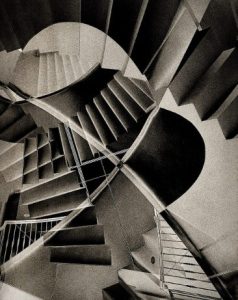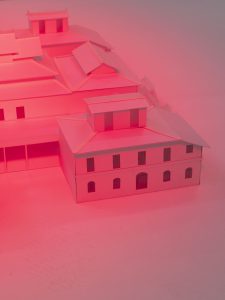מזלג נעוץ בצד “ללא כותרת, (שולחן)”, 2018 של תכלת רם. שיני המזלג תחובות למשטח ההגדלה הנשלף של שולחן כאילו היה המזלג ידית למשיכת המשטח החוצה. המזלג אינו בהכרח הפרט הראשון שבולט בעבודה, צרוף של שולחן, וילון לבן וצמח שצומח מעציץ ומטפס מבעד לעיגול שנפער במשטח השולחן.

עם הווילון וצללית הצמחת השולחן נראה כאילו הפך לתיאטרון בובות או צלליות שילדים יצרו כעולם משלהם, מוקטן ומוגן, מתחת לשולחן והמזלג הנעוץ הוא כמו זריקה של תמהיל מר ואירוני שנמסך בתמימות המשחקית.
השימוש במזלג, כלי האכלה ככלי נשק, יוצר אסוציאציה לאחת מהסצנות האכזריות של “הטבח, הגנב, אשתו והמאהב “(1989) סרטו היפה והאלים של פיטר גרינאוויי, בו באמצע מסעדת פאר ננעץ סכין בלחייה של אחת הדמויות.

רם מדברת על מקומיות בבחירה בשולחן שכמוהו היו במטבחים רבים בארץ במחצית השניה של המאה הקודמת עד שהפך לדימוי כמעט גנרי. היא חותכת בתוכו עיגול, הופכת את השולחן למעין חורבות תרבות שהטבע ומאיים משתלט עליהן, אלא שהטבע פתטי, צמח בעציץ. נוצרת אפוא סיטואציה אלימה ועלובה במידה שווה כשהצמח, המבוית, טורף את השולחן, את סמל הביתיות, כמו מחלה אוטו- אמונית שווילון לבן (כווילון בין מיטות בתי חולים) אינו מסתיר.

תכלת רם ׳גלגל שלישי׳, אוצרת: הילה כהן-שניידרמן
המרכז לאמנות עכשווית CCA
ניוזלטר הפירסומי השבועי של “החלון” בנושאי אמנות, אירועים ותערוכות חדשות
www.smadarsheffi.com/?p=925 (הרישום נפרד מהרישום לבלוג )
לפרטים על סיורי אמנות והצטרפות לקבוצה הקבועה כיתבו ל
thewindowartsite@gmail.com
Follow me on Instagram: smadarsheffi
The aestheticization of violence
A fork is inserted into the side of Tchelet Ram’s Untitled (Table), 2018. The tines are stuck into the table’s expansion panel, as if the fork is its handle. The fork is not necessarily the first detail standing out in the work, which is an assembly of a table, white curtain, and a potted plant climbing through the circle opened up in the surface.

With the curtain and the silhouette of the plant, the table looks like a puppet theatre or shadow play made by children to create their own protected, miniature world. The fork stuck into the table injects a bitter, ironic mixture into the playful innocence.
The use of an eating utensil as a weapon brought to mind one of the scenes of cruelty in Peter Greenaway’s beautiful but violent film, “The Cook, the Thief, his Wife, and his Lover”

(1989), in which a fork is stuck into the cheek of one of the characters in the midst of an opulent restaurant. Ram’s use of the table refers to locality, since this type of table could be found in numerous homes in Israel during the second half of the 20th century, and became an almost generic image. With the circle cut out of the surface, the table turns into a kind of cultural ruin overgrown with natural growth, but here Nature is pathetic, represented by a

potted plant. A violent situation ensues, in which the domesticated plant devours the table, a symbol of domesticity, like an auto-immune disease which the white curtain (reminiscent of dividers in hospital rooms) fails to conceal.
Tchelet Ram, Third Wheel. Curator: Hila Cohen-Schneiderman
CCA-Center for Contemporary Art, Tel Aviv
Join the mailing list for Window’s weekly informational advertising newsletter –
www.smadarsheffi.com/?p=925
For information about Art tours – please write
thewindowartsite@gmail.com






